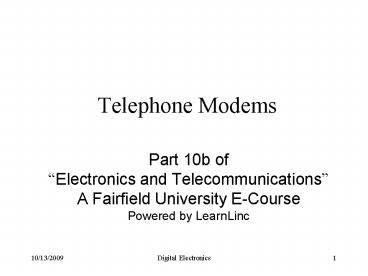Telephone Modems PowerPoint PPT Presentation
1 / 12
Title: Telephone Modems
1
Telephone Modems
- Part 10b ofElectronics and TelecommunicationsA
Fairfield University E-CoursePowered by
LearnLinc
2
Module Digital Systems (in two parts)
- Texts
- Computers, Capron, Benjamin Cummings, 1996,
ISBN 0-10053-0662-5 - Telecommunications, Blyth, McGraw-Hill, 1990,
ISBN 0-02-61001041-2 - Understanding Telephone Electronics, Bigelow,
Newnes, 1997, ISBN 0-7506-9944 - References
- Electronics Tutorial (Thanks to Alex Pounds)
- Electronics Tutorial (Thanks to Mark Sokos)
- Part 9 Computers
- 5 on-line sessions plus one lab
- Part 10 Digital Communications
- 5 on-line sessions plus one lab
- Mastery Test part 5 follows this Module
3
Digital Systems Topics
- Computer Architecture
- Memory ROM, RAM, Cache, Error Checking
- CPU and Program Control
- Secondary Storage Floppy, Hard Drive, CD / DVD
- I/O (Human Video, Keyboard, Pointer)
- Digital I/O Serial, Parallel, IDE, USB.
FireWire, SCSI - Serial I/O RS232
- Modems
- Telephone Modulation and Data compression
- Cable and DSL
- Telephony Digital Transmission
- Packet Transmission
- Fiber Optics SONET
Part 9
Part 10
4
Section 10 Schedule
5
RS232 Review
- DTE (PC) vs DCE (Modem)
- DB25 (DB9) Signal pins
- Asynchronous Data
- Start Bit
- Data bits (7)
- Parity
- Stop bits (2)
6
Modem
- Modem Modulator / Demodulator
- Baseband Serial Data (RS232 TxD RxD)
- Sequence of 0s and 1s
- A time varying DC signal
- The Telephone Channel
- Does not pass DC
- Passes AC from 300 Hz to 3.3 kHz
- Modulation puts the serial data in a form that
can pass through the Telephone Channel - Demodulation is the recovery of the Baseband
Serial data from the corrupted modulated signal.
7
Modulation
- Amplitude Modulation (Amplitude Shift Keying)
- Bit value controls the amplitude of the carrier
(sine wave) - Frequency Modulation (Frequency Shift Keying)
- Bit value controls the frequency of the carrier
(sine wave) - Phase Modulation (Phase Shift Keying)
- Bit value controls the Phase of the carrier (sine
wave) - Here a 1 shifts the phase by 180 A 0 lets
the sine wave continue smoothly
8
Modem Standards
- 300 Baud Bell 103
- 1200 Baud V.23 (FSK)
- 2400 Baud V.22bis (PSK, QAM)
- 9600 Baud V.32
- 14.4 kBaud V.32bis
- 28 kBaud V.42
- 33 kBaud V.42bis (includes data compression)
- 56 kBaud Only on a 64 kBit/s digital channel
9
Data Compression
- Modern modems include data compression
- Lossless no introduced errors
- Two schemes combined to give up to 4x reduction
- Run Length encoding
- Replace a long sequence of 1s (or zeros) with an
escape code and a number representing its length - Dynamic Lemple Ziv keep a dictonary of
repeatedly used sequences at both ends and give
them a short name. Used in V.42bis - Huffman Code Use statistics to give common
sequences short names (Used in Faxes)
10
Modem Handshake a protocol
- Receiving Modem transmits a psuedorandom sequence
of 1s and 0s using its fastest standard. (if no
response, it drops to a slower standard and tries
again) - Sending modem uses the initial signal to
characterize the transmission channel and adjust
an equalizer to compensate for flaws. It then
sends a similar response back to the other end to
allow it to adjust to the channel.
11
Modem Startup
- CTS asserted by modem to tell PC that it is ready
to communicate - PC responds by asserting RTS and asending the
modem the number to be dialed. - The modem dials the number, waits for the ringing
to stop and the modem handshake begins. - When both modems are ready, the CD signal is
asserted and data communication can commence.
12
Section 10 Schedule

